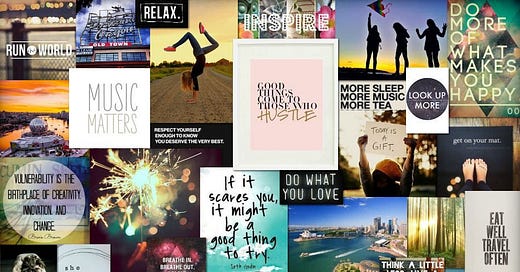How to create a vision board
A physical vision board dramatically improves the precision with which you can create your own future.
The point of alchemy is to live in alignment with your ideal life. This post will guide you through creating your own Vision Board — a simple and effective tool for developing your life’s vision.
Crafting your future
Before we start, it’s important to distinguish between “visions” and “goals”. Visions are very much “big picture”, since they describe the larger patterns of your life. The focus is on creating feelings — abundance, wellbeing, purpose, meaning — rather than identification with particular material outcomes. When we set goals, on the other hand, we tend to be much more specific (e.g., lose 5kgs in 12 weeks). At this stage, we are keeping things very broad; details will come later.
Step 1: Brainstorm
Start by brainstorming the broad aspects of your life that you want to focus on, and then break these down into the key aspects you wish to improve. It’s a good idea to make a small list, like so:
health and fitness — yoga, meditation, nutrition, sports, team work
money and finances — abundance, material needs, equivalent exchange
work and career — meaningful work, progress, long term growth
family — spouse, children, parents, animals, friends
spirituality — rituals, learning, growth, God, community, service
relationships — love, give and take, support, interdependence
hobbies and interests — fun, friends, community, spontaneity
Since we are brainstorming, having too many ideas is better than too few. In later stages we will refine them. Be sure to consider aspects of your ideal life, not just the life you lead currently. Focus more effort toward things that you don’t yet do, or don’t do properly, but would like to develop.
Step 2: Collect content
With your master list in mind, start looking around for images and symbols that resonate with each of your visions. A search engine can help you. For each vision, collect at least 1-3 images that are well aligned with your mental model of your ideal life (quotes and symbols are great too), and store them in a folder. Take your time and find high quality content, but don’t obsess over details too much. You always have the ability to update this vision board at any time. Since this stage is about collecting content and being creative, you don’t need be too discerning just yet.
Step 3: Sort and organise
Once you have all the content you need, remove the relatively low-quality material, and ensure you’ve covered the bases on your master list. You can use a tool like powerpoint, canva, or google slides to create a collage of all the images, symbols, and quotes you collected. Below is an example of a vision board that incorporates a generous mix of photos, quotes, and unique content.
When you’re ready, arrange your vision board in a way that you find pleasing. As you put everything together, you might find that you have too much focus on one area of your life, or alternatively there’s an obvious lack of detail in another area. Take note of the way things fit together and make any necessary adjustments. The more personally meaningful your vision board, the more effectively you will prime the relevant emotional state. This doesn’t have to be completed in one sitting, so feel free to leave it aside and come back to it.
Step 4: Put it where you will see it
Now that you’ve imagined your ideal life, and created a visual reminder of your ideals, you can use the board to orient your behaviour in the short-, mid-, and long-term. Take steps each day to advance one or more of your core visions. Essentially, this board helps you program your mind to attract these things into your life, since now you’ve defined exactly what you’re aiming toward (the benefit of this will become increasingly clear when we get to goal-setting and daily routines). Remember that this is a work in constant progress, so when you have a new vision, make sure you update your board!
Conclusion
A vision board helps you dream big and feel what it would be like to live your ideal life. When creating the vision board, keep in mind that you want to strike the right balance between “big picture” and “precise detail”. If your images are too vague, you won’t properly resonate with the vision. However, if it’s too detailed, you risk becoming too attached to a particular outcome. In other words, you might miss real opportunities because you were too focussed on some irrelevant detail. Remember to focus on the feelings of abundance, wellbeing, purpose, and meaning rather than specific details and material outcomes — try not to “miss the forest for the trees”.
Final thoughts
If you’d like to further understand the power of having a life’s vision, I recommend watching the below video. Neuroscientist Dr Joe Dispenza explains how we can use visualisation to reprogram the mind and create our intended future. (Link here).




